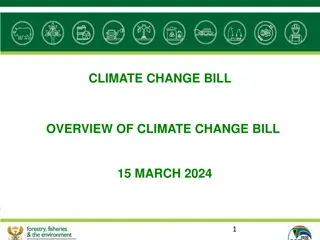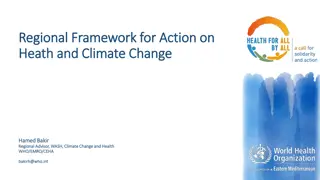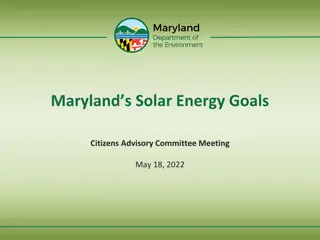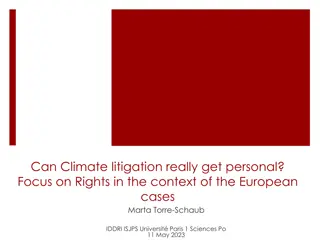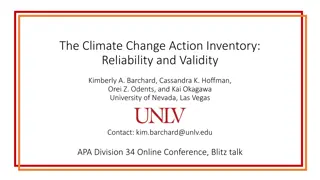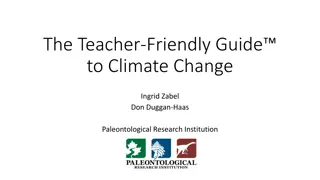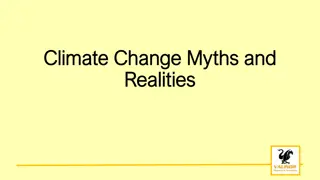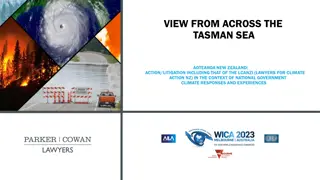International Legal Framework and Climate Change Challenges
The international legal framework for addressing climate change, including the UN Framework Convention on Climate Change (UNFCCC) and the Kyoto Protocol, aims to mitigate greenhouse gas emissions and promote adaptation measures. Despite efforts, progress has been slow with challenges in meeting targets and securing commitments from major countries.
Download Presentation

Please find below an Image/Link to download the presentation.
The content on the website is provided AS IS for your information and personal use only. It may not be sold, licensed, or shared on other websites without obtaining consent from the author.If you encounter any issues during the download, it is possible that the publisher has removed the file from their server.
You are allowed to download the files provided on this website for personal or commercial use, subject to the condition that they are used lawfully. All files are the property of their respective owners.
The content on the website is provided AS IS for your information and personal use only. It may not be sold, licensed, or shared on other websites without obtaining consent from the author.
E N D
Presentation Transcript
International Legal Framework Comparing basic principles of climate change & international economic regulation
UN Framework Convention on Climate Change (UNFCCC) Opened for signature at 1992 UN Conference on Environment and Development, Rio de Janeiro. Entered into force in 1994. 1992 UN Conference also produced Rio Declaration (27 international environmental protection principles) Agenda 21 (UN s Environment and Development Agenda)
1992 UNFCCC ultimate objective = mitigation (informs interpretation) to achieve, in accordance with the relevant provisions of the Convention, stabilization of greenhouse gas concentrations in the atmosphere at a level that would prevent dangerous anthropogenic interference with the climate system. Such a level should be achieved within a time frame sufficient to allow ecosystems to adapt naturally to climate change, to ensure that food production is not threatened and to enable economic development to proceed in a sustainable manner.
COP 18 (2012): renewed focus on adaptation Parties reiterated their determination to achieve the 1992 objective, BUT: adaptation must be addressed with the same priority as mitigation enhanced action and international cooperation on adaptation is urgently required
1997 Kyoto Protocol binding emissions targets for industrialized countries with a view to reducing their overall emissions of such gases by at least 5 per cent below 1990 levels in the commitment period 2008 to 2012 2012 COP 18: Australia and European countries extended their Kyoto commitments (1 January 2013 to 31 December 2020) US never ratified, Canada withdrew, Japan and Russia not making new commitments
Signs that UNFCCC Parties are not advancing quickly enough Failure to stabilize GHG emissions Shifting focus to adaptation Shrinking Kyoto commitments among industrialized countries Lack of commitments from major developing countries Unilateral measures in response to the failures of the UNFCCC and Kyoto processes
Sustainable Development Principle
1992 Rio Declaration References to sustainable development anthropocentric meet developmental and environmental needs of present and future generations integrate environmental protection into the development process poverty eradication and decreasing economic disparities changes to production and consumption and appropriate demographic policies technology development and transfer an open international economic system the full participation of women the creativity, ideals and courage of the youth of the world the effective participation of indigenous people and other local communities environmental protection during wars peace, development and environmental protection cooperation in the further development of international law
UNFCCC references to sustainable development No binding sustainable development obligation Greater emphasis on economic growth than the Rio Declaration Example: sustainable social and economic development (preamble)
UNFCCC disputes go to ICJ or arbitration Gab kovo-Nagymaros: concept of sustainable development refers to the need to reconcile economic development with protection of the environment Pulp Mills on the River Uruguay: refers to the need to strike a balance between the use of the waters and the protection of the river consistent with the objective of sustainable development . BUT you need conclusive evidence of environmental harm to secure an order for restitution or to pay compensation, which may be difficult to achieve given the current uncertainty regarding the exact causes and effects of climate change.
US Shrimp, WTO Appellate Body AB referred to sustainable development to support its interpretation of GATT Article XX(g). References to environmental protection and sustainable development in WTO Agreement preamble. The generic term natural resources in Article XX(g) is not static in its content but is evolutionary . Should take into consideration the international community s efforts to protect living natural resources.
2001 WTO Ministerial Declaration Members strongly reaffirmed commitment to objective of sustainable development Says open and nondiscriminatory multilateral trading system, and acting for the protection of the environment and the promotion of sustainable development can and must be mutually supportive Relevant to interpret WTO law (per VCLT) Suggests acceptance of prior jurisprudence
Measures to address climate change Likely to qualify as relating to the conservation of an exhaustible natural resource linkage between climate change and sustainable development: US Shrimp WTO jurisprudence that clean air is an exhaustible natural resource: US Gasoline Could be measures necessary to protect human, animal or plant life or health, Obiter dictum of Appellate Body in Brazil Retreaded Tyres Subject to the requirement that they are not applied in a manner which would constitute a means of arbitrary or unjustifiable discrimination between countries where the same conditions prevail, or a disguised restriction on international trade, and are otherwise in accordance with the provisions of the WTO Agreements
Legal effect Sustainable development too vague to be a rule of customary international law States have right to exploit their resources, subject to responsibility to not cause environmental damage beyond their borders Can be taken into account in treaty interpretation, depending on the specific treaty language (WTO, CIJ)
Concept of sustainable development Does not create specific obligations for States with respect to climate change. In treaties in which sustainable development forms part of the preamble or is otherwise incorporated into the treaty text, it can influence the interpretation of that treaty. However, this concept can not be used to alter clearly stated obligations in treaties.
Rio Declaration Principle 15 In order to protect the environment, the precautionary approach shall be widely applied by States according to their capabilities. Where there are threats of serious or irreversible damage, lack of full scientific certainty shall not be used as a reason for postponing cost-effective measures to prevent environmental degradation.
UNFCCC Article 3(3) The Parties should take precautionary measures to anticipate, prevent or minimize the causes of climate change and mitigate its adverse effects. Where there are threats of serious or irreversible damage, lack of full scientific certainty should not be used as a reason for postponing such measures . Hmmm .
Liability for damage caused by climate change? COP 18, Preamble to document regarding loss and damage that climate change causes to developing countries: the lack of full scientific certainty should not be used as reason for postponing action . This does not create an obligation to compensate vulnerable developing countries for the damage caused by climate change. Difficult to allocate responsibility for damage caused by climate change, due to the complexity of proving causation.
Gabkovo-Nagymaros (Hungary v. Slovakia) ICJ Hungary argued that a general obligation of prevention of damage pursuant to the precautionary principle precluded performance of its treaty with Slovakia. ICJ: Treaty can be terminated only on the limited grounds enumerated in the Vienna Convention. Sum: The precautionary principle cannot be invoked to excuse performance of a treaty or to terminate a treaty, unless the treaty says so.
EC Hormones WTO Appellate Body AB rejected the precautionary principle as a defense SPS Agreement. AB: status of precautionary principle in international law awaits authoritative formulation. AB: principle has not been written into SPS Agreement as a ground for justifying SPS measures that are otherwise inconsistent with its specific provisions. Like Gab kovo-Nagymaros, confirms that effect of precautionary principle on a treaty depends on the specific treaty language.
Effect on treaty interpretation Leeway treaty interpreter has depends on degree of ambiguity of specific provision. Due to time GHGs remain in atmosphere, risk of irreversible environmental damage (at least in the short to medium term). Implies serious increases in risks to human health from diseases, malnutrition, severe weather. Even if precautionary principle achieves status of customary international law, it will not override clear treaty provisions. It could support argument that a measure relates to environmental protection (IIAs, GATT Art. XX(g)).
Common but differentiated responsibilities (CDR)
CDR in Rio Declaration Principle 7 States shall cooperate in a spirit of global partnership to conserve, protect and restore the health and integrity of the Earth's ecosystem. In view of the different contributions to global environmental degradation, States have common but differentiated responsibilities. The developed countries acknowledge the responsibility that they bear in the international pursuit to sustainable development in view of the pressures their societies place on the global environment and of the technologies and financial resources they command.
CDR in UNFCCC Article 3(1) The Parties should protect the climate system for the benefit of present and future generations of humankind, on the basis of equity and in accordance with their common but differentiated responsibilities and respective capabilities. Accordingly, the developed country Parties should take the lead in combating climate change and the adverse effects thereof.
CDR in public international law No agreement on what CDR means or when it applies. Lack of mitigation resources is not a defense for responsibility of States to ensure that activities within their jurisdiction do not cause damage to the environment in other States or in areas beyond the limits of their jurisdiction. Differential obligations are the exception.
3 arguments in favor of differentiation (1)needs/vulnerability; (2)contribution to the problem; (3) financial and technological capacity to resolve the problem. BUT these vary over time.
UNFCCC on CDR now outdated Financial and technological landscape have changed due to: growth of technological capacities, economies and emissions of countries like China; reduction in debts of major developing countries like Mexico; & financial crises in Japan, the United States and the European Union. Brazil, China, India, Indonesia, Mexico, Russia will join the league of developed countries.
Critique of CDR Too simplistic categorization of countries. Has become an obstacle to reaching international agreements to address climate change. Financial and technological endowments of countries are not frozen in time. Vulnerability varies, independent of finances and technology. Makes more sense to assign responsibility for the cost of mitigation and adaptation on a scale, based on objective criteria.
Special and differential treatment (comparable principle in WTO law) Most of the special and differential treatment provisions in the WTO Agreements are not binding in a meaningful way. CDR cannot override the text of the WTO agreements any more than special and differential treatment or the precautionary principle can. Both the text and the context of the WTO Agreements indicate that CDR would have a limited role in interpretation.
WTO law probably not inconsistent with principle of CDR US Shrimp: GATT Article XX chapeau requires flexible application of measures that takes into account the conditions prevailing in different countries. Brazil Retreaded Tyres, AB took Brazil s level of technological and economic development into consideration in rejecting an alternative approach to environmental protection (Art. XX(b). EC Tariff Preferences, countries in similar financial and economic circumstances should be treated similarly under Enabling Clause. BUT, in WTO disputes, specific circumstances of each case and each country and the specific terms of WTO provisions will be more relevant than CDR.
Polluter-Pays Principle (PPP) Polluting parties liable to pay for the environmental damages they cause. Shift the responsibility from governments to the polluting entities. Examples: Cap-and-trade programs and carbon taxes Two policy approaches: command-and-control approach (to prevent environmental problems by regulating how a company should manage a pollution-generating process) market-based approach (charges fees or taxes to polluters)
Rio Declaration Principle 16 National authorities should endeavour to promote the internalization of environmental costs and the use of economic instruments, taking into account the approach that the polluter should, in principle, bear the cost of pollution, with due regard to the public interest and without distorting international trade and investment.
UNFCCC does not incorporate PPP Lets Parties determine how to implement obligations. Combines financing for and technology transfer to developing countries with the absence of emissions reduction commitments for developing countries. Developed country governments are to pay for mitigation and adaptation, at least in developing countries, rather than private sector polluters. Part of mandate of the Green Climate Fund is to provide for effective direct and indirect public and private-sector financing by the Green Climate Fund. Fossil fuel subsidies are opposite of PPP.
Environmental Impact Assessment
Rio Declaration Principle 17 Environmental impact assessment, as a national instrument, shall be undertaken for proposed activities that are likely to have a significant adverse impact on the environment and are subject to a decision of a competent national authority.
UNFCCC lacks EIA obligation of Rio Declaration UNFCCC does not refer to environmental impact assessments. Refers instead to adverse effects on economy, public health and quality of the environment of climate change measures themselves. Kyoto Article 2(3) also concerned primarily with the adverse effects of climate change measures, especially on developing country Parties. BUT, all of the UNFCCC Parties must now be considered bound to conduct EIAs, in the light of recent developments in customary international law.
Pulp Mills on the River Uruguay (Argentina v. Uruguay) The practice of EIA has gained so much acceptance among States that it may now be considered a requirement under general international law to undertake an environmental impact assessment where there is a risk that the proposed industrial activity may have a significant adverse impact in a transboundary context, in particular, on a shared resource. BUT general international law does not specify the scope and content of an EIA.
EIA and liability Scope and content of the EIA would have to take into account risk posed to other States. This does not entitle the affected State to prevent the activity. BUT it could affect the liability of the State that proceeds with the activity in question.
Implications for unilateral measures to address climate change. A State has an obligation to take into account the impacts of a unilateral measure on other States in the process of designing the measure. There also may be an obligation to consult other States at the design stage. In the case of trade measures, the absence or presence of such an EIA may affect the outcome of the analysis in GATT Article XX and similar WTO provisions.
Unilateral Measures & State Jurisdiction
Principle 12 of the Rio Declaration States should cooperate to promote a supportive and open international economic system that would lead to economic growth and sustainable development in all countries, to better address the problems of environmental degradation. Trade policy measures for environmental purposes should not constitute a means of arbitrary or unjustifiable discrimination or a disguised restriction on international trade. [Read as shall not ?]] Unilateral actions to deal with environmental challenges outside the jurisdiction of the importing country should be avoided. Environmental measures addressing transboundary or global environmental problems should, as far as possible, be based on an international consensus. [US Shrimp: only requires good faith efforts.] Sum: preference for international consensus over unilateral actions, but without prohibiting unilateral actions.
UNFCCC Article 3(5) does not rule out unilateral measures. Measures taken to combat climate change, including unilateral ones, should not constitute a means of arbitrary or unjustifiable discrimination or a disguised restriction on international trade
Paragraph 6, Doha Ministerial Declaration implicitly allows unilateral measures We recognize that under WTO rules no country should be prevented from taking measures for the protection of human, animal or plant life or health, or of the environment at the levels it considers appropriate, subject to the requirement that they are not applied in a manner which would constitute a means of arbitrary or unjustifiable discrimination between countries where the same conditions prevail, or a disguised restriction on international trade, and are otherwise in accordance with the provisions of the WTO Agreements.
2 cases support use of unilateral measures to address climate change EU Directive 2008/101 (Aviation Directive): ECJ accepted right of the EU to use a unilateral climate change measure in light of the Kyoto Protocol and customary international law. US Shrimp (Article 21.5 Malaysia) : WTO AB accepted right of US to use a unilateral environmental protection measure under GATT Article XX.
EU Directive 2008/101 (Aviation Directive) Kyoto Art. 2(2) requires Annex I Parties to pursue limitation or reduction of emissions of greenhouse gases from aviation bunker fuels, working through the International Civil Aviation Organization . After insufficient Kyoto progress, EU unilaterally applied its directive to EU and non-EU airlines. ECJ: does not breach Kyoto 2(2) because 2(2) is not unconditional and is not sufficiently precise. ECJ: does not breach customary international law principles of state sovereignty because it applies only to aircraft that choose to operate in EU airspace. EU law can apply to matters contributing to the pollution of the air, sea or land territory of the Member States even where they originate in an event which occurs partly outside EU territory.
US Shrimp (Article 21.5 Malaysia) US banned shrimp imports from WTO members that did not comply with US requirements to protect sea turtles. AB: unilateral measures can be included in Art. XX(g). AB: Rio Declaration as far as possible indicates preference for multilateral solutions, but does not require that a multilateral agreement be concluded. Sum: WTO Member can justify unilateral recourse to trade restrictions to induce changes in the environmental practices of other Members.









